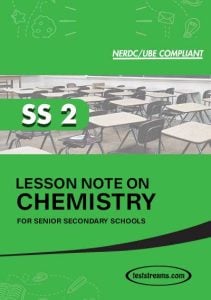This CHEMISTRY Lesson Note was pulled from our book (Lesson Note on CHEMISTRY for SS2 MS-WORD); Compiled to serve as reference material to help teachers draw out their lesson plan easier, saving you valuable time to focus on the core job of teaching.
This CHEMISTRY Lesson Note Covers The Following Topics
- PERIODIC TABLE
- OXIDATION-REDUCTION REACTION
- PERIODIC TABLE AND ATOMIC PROPERTIES
- IDENTIFYING OXIDIZING AND REDUCING AGENTS
- IONIC THEORY
- ELECTROLYSIS
- ELECTROLYSIS OF SPECIFIED ELECTROLYTES
- ELECTROCHEMICAL CELL
- APPLICATION OF ELECTROCHEMICAL CELL
- FARADAY’S LAW OF ELECTROLYSIS AND
- CALCULATIONS
- RATE OF REACTIONS
- TYPES OF CHEMICAL REACTIONS
- CHEMICAL EQUILIBRIUM
- NON – METALS: HYDROGEN
- OXYGEN
- HALOGENS
- NITROGEN FAMILY
- COMPOUNDS OF NITROGEN
- SULPHUR
- COMPOUNDS OF SULPHUR
- SOLUBILITY
- INTRODUCTION TO ORGANIC CHEMISTRY – HYDROCARBONS
- MASS AND VOLUME RELATIONSHIPS
- ACID-BASE REACTION
- SATURATED HYDROCARBONS- ALKANES
- UNSATURATED HYDROCARBON- ALKENES
- HYDROCARBONS – ALKYNES
- ALKANOLS
Sample note
Week 1
Topic: Periodic Table
Introduction
The most important classification in chemistry is the arrangement of the elements in the periodic table.
In 1869, Mendeleev, a Russian scientist, was the first to construct a periodic table. He arranged the elements in order of increasing relative atomic mass. He pointed out that elements with similar properties kept recurring at regular intervals or periods.
Mendeleev’s periodic table had many gaps. He predicted that there were undiscovered elements which could fill these gaps. He even predicted the possible properties of these elements. Later, elements such as scandium, gallium, germanium etc. were discovered, which not only fitted exactly into Mendeleev’s table, but also had the properties he predicted.
Periodic table helps us to correlate the properties of the elements and thus remember their chemistry. With the discovery of the electronic structure of the atoms, it became clear that elements do vary. regularly, not with their relative atomic mass, but with their atomic number. The modern periodic law states that the properties of the elements are a periodic function of their atomic numbers.
Electronic Configuration of Atoms as the Basis of the Periodic Table
The atomic number is the number of protons in an atom. As an atom is neutral, the number of protons is equal to the number of electrons. The electrons and their arrangement in the atom of an element are responsible for many of the properties of the element.
An atom consists of a central positively charged nucleus with electrons revolving around it at great speed. The electrons are negatively charged and revolved around the nucleus in a spherical region called shells or orbits or energy levels situated at various distances from the nucleus. Electrons in shell nearer to the nucleus possess less energy than those further away. Starting from the shell nearest the nucleus, the shells are named as K, L, M, N, O,… These corresponding to the energy levels numbered, 1, 2, 3, 4, 5,… An atom may have several electron shells but all the electrons in a given shell possess approximately equal energy. The maximum possible number of electrons in a shell is given by the formula 2n2, where n is the energy level number of the shell.
Groups and Periods
The modern form of periodic table is divided into eight vertical columns known as groups and seven horizontal rows known as periods.
GROUPS: The vertical columns of elements or groups, are numbered from 0 to 7. Elements in the same group have the same number of electron in the outermost shell of their atom i.e. they have the same number of valence electrons. Hydrogen does not fit into any group. But for convenience, it is placed in Group 1 because of the single electron. In Group 0, helium has two electrons, while the other elements have eight valence electrons. Besides the eight main groups, there are also the transition groups of elements. These lie between Group 2 and 3 in the periodic table.
PERIODS: The horizontal rows of elements, or periods, are numbered from 1to 7. Elements in the same periods have the same number of electron shells i.e. elements of periods 2 have two electron shells (K,L), those of periods 3 have three (K,L,M), and so on. The number of valence electrons of the elements in the same periods increases progressively by one across the period from left to right. Among the elements in the periods 6 and 7 are the elements of the lanthanides and actinide series respectively. They are also known as the inner transition elements.
Metals, Metalloids and Non –Metals
The periodic table shows a diagonal division of the elements into metals and non-metals. The metals are found on the left side of this line and the non-metals on the right. The metalloids occur along the boundary line.
Electronic Configuration and Periodic Table
Group 1 and Group 2 make up the S-block. The elements in this block are the reactive alkali metals and alkaline earth metals. Group 3 to 7 and 0 form the P-block. Electrons are added progressively to the P-orbital s as we move across the table from Group 3 to 7 and0. The elements in the P-block change from moderately active metals in Group 3 to the very active non-metals in Group 7, and finally the unreactive noble gases in Group 0. The transition elements occur between Group 2 and 3 and form the D-block because they contain D electrons in addition to the S and P electrons. The lanthanides and the actinides also occur between Group 2 and 3 in periods 6 and 7 respectively. They form the F-block because they contain F electrons in addition to the S, P, and D electrons.

Get the complete Lesson Note with more content at very affordable price. Lesson Note on CHEMISTRY for SS2 MS-WORD- PDF
![]()




